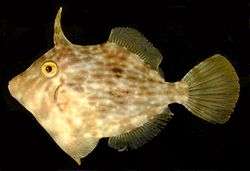Stephanolepis hispidus
| Planehead filefish | |
|---|---|
 | |
| Scientific classification | |
| Kingdom: | Animalia |
| Phylum: | Chordata |
| Class: | Actinopterygii |
| Order: | Tetraodontiformes |
| Family: | Monacanthidae |
| Genus: | Stephanolepis |
| Species: | S. hispidus |
| Binomial name | |
| Stephanolepis hispidus (Linnaeus, 1766) [1] | |
| Synonyms[1] | |
| |
Stephanolepis hispidus, the planehead filefish, is a species of bony fish, a ray-finned fish in the family Monacanthidae.
Description
The planehead filefish grows to a maximum length of 27 centimetres (11 in) but is more typically about 17 centimetres (6.7 in) long. The colour is cryptic, being a more or less mottled pale brown, olive or green on a light coloured background, sometimes with darker brown splotches and streaks. The fish is laterally compressed and deep bodied. The snout is elongated with a terminal mouth. The large yellow eye is set high on the head and above it is a prominent retractable spine. This is the anterior of the 2 spines associated with the long dorsal fin, which also has 29 to 35 soft rays. The anal fin has no spines and between 30 and 35 soft rays. The pectoral fins are small and the tail fin is large and fan-shaped, often with two darker coloured bands.[2][3][4]
Distribution and habitat
The planehead filefish is found in the Atlantic Ocean at depths of up to 300 metres (980 ft). Its range extends from Nova Scotia to Uruguay in the west and from the Canary Islands to Angola in the east. It is found near the seabed on reefs and over sandy and muddy sea floors. It is often found among Sargassum seaweed.[2]
Biology
In the Canary Islands the growth and ageing of the planehead filefish have been studied. Spawning takes place in the summer and the age of the fish is established by using the fast and slow growth rings found in the anterior dorsal fin spine.[5] The species has a lifespan of about three years and reaches half its final length by the end of its first year.[5]
Uses
The planehead filefish can be used for human consumption. In the Canary Islands it is caught in fish traps and at one time was considered to be a by-catch, incidental to the capture of other, more desirable fish. However, since the 1980s, it has become a target species in its own right and by 2000, there were concerns about overfishing.[5]
References
- 1 2 Bailly, Nicolas (2010). "Stephanolepis hispidus (Linnaeus, 1766)". World Register of Marine Species. Retrieved 2012-01-04.
- 1 2 Stephanolepis hispidus (Linnaeus, 1766) FishBase. Retrieved 2012-01-04.
- ↑ Stephanolepis hispidus, Marine Species Identification Portal. Retrieved 2012-01-04.
- ↑ Frederick H. Berry and Louis E. Vogele (1959). "Filefishes (Monacanthidae) of the western North Atlantic" (PDF). Fishery Bulletin. 61: 61–109.
- 1 2 3 Berry, Frederick H.; Voegle, Louis E. (2004). "Age and growth of Stephanolepis hispidus (Linnaeus, 1766) (Pisces: Monacanthidae), in the Canary Islands area". Fisheries Research. 66 (2-3): 381–386. doi:10.1016/j.fishres.2003.07.002.